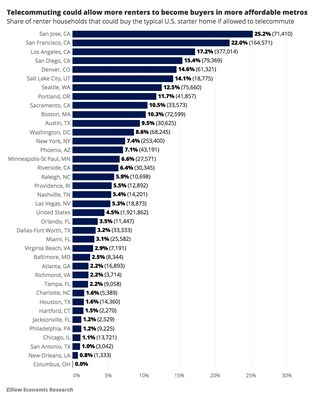Remote Work Could Open Homeownership to Nearly Two Million Renter Households
SEATTLE, Sept. 8, 2020 /PRNewswire/ -- Zillow's analysis reveals that nearly two million renter households could afford a typical U.S. starter home if remote work becomes a long-term option. In cities like San Francisco, 22% of renters priced out of homeownership can afford monthly payments on a starter home priced at $725, compared to $5,181 in the city. Millennials make up nearly half of these potential buyers. While the pandemic has altered housing preferences, proximity to work and other factors will influence their decisions.
- Nearly 2 million renter households could afford homeownership with remote work flexibility.
- In San Francisco, 22% of renters priced out could afford a starter home nationwide.
- Millennials (ages 26-40) represent nearly half of potential first-time buyers.
- The shift to telework may reshape the U.S. housing market.
- Not all renters will find affordable homes outside their metro areas.
- High levels of student debt continue to challenge millennials' downpayment savings.
- Only 61% of millennial renters are likely to consider buying a home.
Insights
Analyzing...
SEATTLE, Sept. 8, 2020 /PRNewswire/ -- The rise of remote work has the potential to unlock the American Dream of homeownership for nearly two million renter households. A new Zillow® analysis finds that's how many renter households could likely telecommute and afford monthly payments on the typical U.S. starter home, but couldn't afford a starter home in their current metro.1
The numbers are more pronounced in expensive coastal metros like San Francisco, where
In cities such as Minneapolis, Phoenix and Denver, the opposite is true. In Denver, for example, starter homes in the city are more affordable than in the metro area, yet
Not all renters will find it more affordable to buy a home outside their current metro areas. Places such as Pittsburgh, El Paso and Rochester offer more affordable starter homes than the country as a whole, meaning aspiring buyers would have to pay more if they wanted to leave.
Zillow's analysis looked at renter households for whom monthly payments on a starter home in their metro are unaffordable, but would be affordable on the typical U.S. starter home. Those households were then assigned a probability of being able to telecommute based on income, the worker's industry and occupation.
"If remote work becomes a bona fide long-term option especially with the pandemic, that could reshape the U.S. housing market by opening up homeownership to people renting in expensive parts of the country," said Zillow economist Jeff Tucker. "However, it's unclear how many people would make the move to buy their first home. Proximity to work is just one of the factors people consider when choosing where to live. Other factors may keep them from moving including proximity to friends and family, cultural and natural amenities, and their kids' schools."
The pandemic-led shift to telework has already upended housing preferences, as people rethink how and where they want to live. A previous Zillow survey from the Harris Poll found that if given the option to continue working from home, at least occasionally,
Millennials, between 26 and 40 years old, represent nearly half of the 1.92 million renter households who could afford homeownership if given the flexibility to work from home, the largest generational group to benefit from these new options. The average age of these potential movers is 38.
Millennials had been dubbed the "doomed generation," as a complex tangle of overlapping factors made first-time homeownership a pipe dream for so many. Rapid home price growth outpaced income growth, and a severe inventory shortage sparked intense competition for starter homes, locking many first-time buyers out of the market. High levels of student debt have also made it difficult to save for a downpayment, driving 8.6 million millennials to move back home with Mom and Dad as of June 2020.
The American Dream may have been delayed, but it hasn't lost its luster for this generation. In a 2020 Zillow survey,
"Two-thirds of our buyers are millennials," said Zillow Premier Agent Holly Mellstrom, a Pelham, NY-based associate broker at Julia B. Fee Sotheby's International Realty. "They're looking to put down roots and get more space for their money after high-rise city living. Many have young families and were planning to move to the suburbs in the future, but they're making the move now because they don't anticipate having to commute into the city to work everyday."
Chris Chan, 40, and his wife, Eunice Lee, 35, became home buyers during the pandemic, moving from a two-bedroom co-op in Brooklyn to a five-bedroom house in Westchester County, NY.
"The tipping point was envisioning both of us working from home indefinitely alongside our daughter and a second child on the way," said Chan, who works in Connecticut. "We wanted to maintain the balance between space and proximity to the city. We could get more for our money just outside city limits and we're still only 30 minutes from Grand Central Station."
About Zillow
Zillow, the top real estate website in the U.S., is building an on-demand real estate experience. Whether selling, buying, renting or financing, customers can turn to Zillow's businesses to find and get into their next home with speed, certainty and ease.
In addition to for-sale and rental listings, Zillow Offers buys and sells homes directly in dozens of markets across the country, allowing sellers control over their timeline. Zillow Home Loans, our affiliate lender, provides our customers with an easy option to get pre-approved and secure financing for their next home purchase.
Millions of people visit Zillow Group sites every month to start their home search, and now they can rely on Zillow to help them finish it — with the same confidence, ease and empowerment they've come to expect from real estate's most trusted brand.
Zillow is owned and operated by Zillow Group, Inc. (NASDAQ:Z and ZG).
1 Methodology: HHs for whom expected monthly payments on a starter home (30-year
2 Estimated monthly payments were calculated assuming a 30-year fixed rate mortgage at a
3 Zillow Group partnered with independent market research and data analytics firm YouGov® to conduct a nationally representative, online quantitative survey that gathered information from a total of 13,000 key household decision makers, including 3000 buyers, 3000 sellers, 3000 renters that moved in the past year, 3000 homeowners, and 1000 new construction buyers. For more information visit zillow.com/report
![]() View original content to download multimedia:http://www.prnewswire.com/news-releases/remote-work-could-open-homeownership-to-nearly-two-million-renter-households-301124719.html
View original content to download multimedia:http://www.prnewswire.com/news-releases/remote-work-could-open-homeownership-to-nearly-two-million-renter-households-301124719.html
SOURCE Zillow








